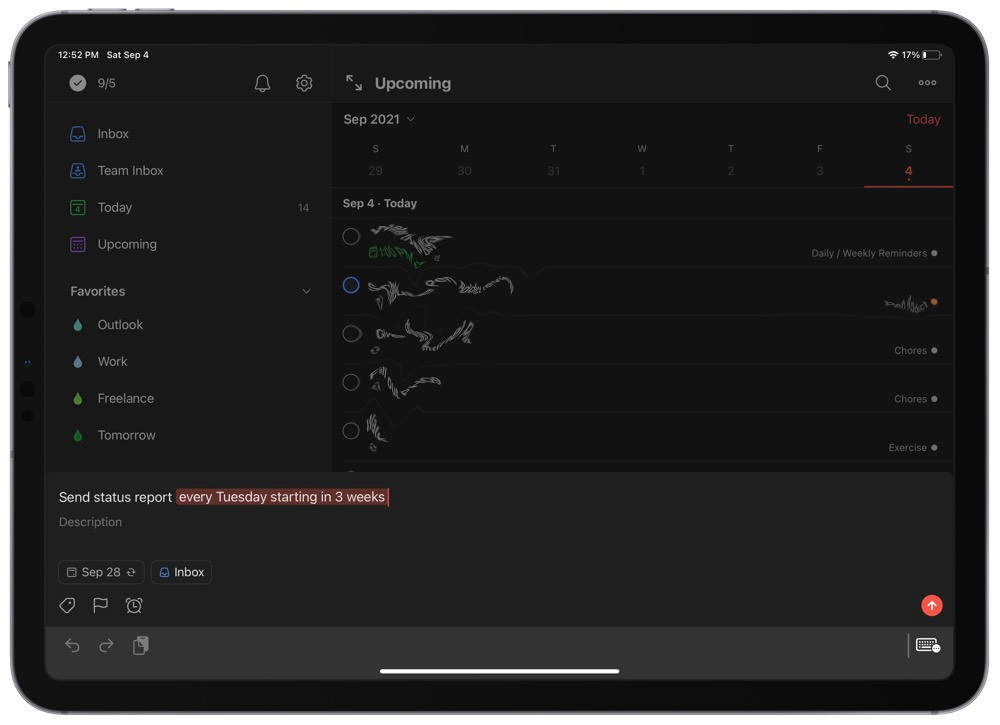

Todoist: Shortcomingsįor all its compelling advantages, Todoist still has a lot of rough edges that bother me. Things is only available for Apple platforms, with no web view and no apparent plans to expand to others. Todoist is available on every mobile and desktop platform on the market, including the web. If you use Google Calendar, there’s also a potent two-way sync available. Similarly, you can generate a calendar subscription link for any project, allowing you to view your tasks (or allow collaborators to view them) in your calendar system of choice. Projects can be shared, and every project, task, and subtask gets its own dedicated comment thread for easy discussion. Todoist, on the other hand, was built for collaboration.

Things remains unaware of other people, offering no ability to share or collaborate in a useful way.Īs an individual task management system, that’s fine, but it means that many Things users-myself included-are stuck employing a different app for lists or tasks that need to be shared with a spouse, friend, or teammate. In Todoist, I can simply enter a task using every three weekdays and Todoist handles it perfectly. Even something simpler, like repeating every other weekday, I would have to set up manually in the repeat settings for the task. In Things, tasks can repeat weekly or daily, but there’s no awareness of weekends, so it’s impossible for me to set up this particular repeat pattern. For example, I have a repeating task that I only want to appear every third weekday. Speaking of scheduling, Todoist’s understanding of dates and repeating tasks is more sophisticated than Things’. If you use every! instead of every, then Todoist establishes that completion dependency and you get tasks that repeat on schedule only when you’ve completed the current instance. In Things, when you’re in the dedicated repeat settings for a task, you can choose whether or not you want the repeat to depend on the completion of the current instance, and I thought this wasn’t possible in Todoist until I discovered this syntax trick. This natural language syntax does indeed create a repeating task, but it repeats daily with no regard for the completion of its predecessor. The reason it happens is that I was typing in something like wash some dishes every day. In many cases, this resulted in a string of nonsensical duplicates. In the past, when I had repeating tasks, they would repeat whether or not I had completed the previous instance. That being said, relying on natural language means that you end up having to remember some syntax tricks for more complex scenarios.įor example, it was only recently that I learned about the every! command, which allows you to create tasks that repeat on a schedule but only after the previous instance has been completed. Even setting aside the time burden, the simple mental ease that this provides is hard to overstate-nothing I’ve tried makes capturing tasks feel as effortless and joyful as Todoist. As a result, I want to quickly enter a new task and organize it in the same step, removing the need to subsequently sort through a messy inbox. This workflow has never worked for me because I almost always know exactly where and when each task is for when I enter it.

Many task management apps want you to use the Inbox to capture tasks in a very rough form, returning later to properly schedule and file them into the appropriate list. More than ever, that capability sets Todoist apart from the competition for speed of capture. To my mind, the defining feature of Todoist is the natural language task input. So how do they compare nowadays? I thought I’d offer a set of strengths and shortcomings for each one, a highlight reel of sorts that you can use to determine which one is a better fit for your needs. Things, meanwhile, has also been steadily improving, with important quality of life additions like the overhauled Quick Find and the incredible Type Travel feature making its way to iPadOS. It brought many useful refinements, including proper sections, a familiar drag-and-drop quick add button on iOS and Android, a new task detail view, and revised iconography throughout. Over time, I’ve mostly settled on using Things, but as I tend to do once or twice per year, I switched back to using Todoist for a few weeks to see how things have changed and improved over the past few months.ĭoist (the company that makes Todoist and Twist) recently unveiled one of the largest updates to Todoist in recent memory, a broad overhaul they called Todoist Foundations. It always comes down to a choice between these two productivity powerhouses for me.


 0 kommentar(er)
0 kommentar(er)
